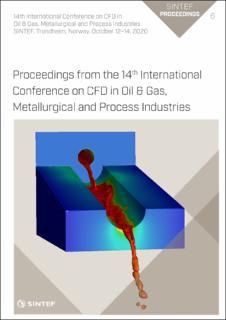| dc.contributor.author | MANISCALCO, Francesco | |
| dc.contributor.author | SHIEA, Mohsen | |
| dc.contributor.author | BUFFO, Antonio | |
| dc.contributor.author | MARCHISIO, Daniele | |
| dc.contributor.author | VANNI, Marco | |
| dc.date.accessioned | 2020-12-22T20:09:53Z | |
| dc.date.available | 2020-12-22T20:09:53Z | |
| dc.date.issued | 2020 | |
| dc.identifier.isbn | 978-82-536-1684-1 | |
| dc.identifier.issn | 2387-4295 | |
| dc.identifier.uri | https://hdl.handle.net/11250/2720843 | |
| dc.description.abstract | Gas-liquid bubble columns are commonly used in the process industry due to their ease in construction and their excellent performances. However, the formulation of numerical models of such industrialscale systems is troublesome especially because of the strong coupling between the phases. In fact, it is crucial to properly describe the phase coupling in the Euler-Euler framework in terms of the drag and other interfacial forces. This is particularly important at high gas superficial velocity, when the global gas fraction is higher and the drag coefficient is very different from that for isolated particles. One way of addressing the problem is coupling a correction for the swarm effect occurring at relatively high gas fractions with a blending approach, which sets a natural transition of the drag force in the phase inversion region. The numerical simulations were carried out with the CFD code OpenFOAM. While in commercial codes the application of methods of this kind is not always mentioned, in open-source codes, such as OpenFOAM, it is possible to prescribe completely all the settings of the procedure. As a first step of the work, we performed an accurate study on a proper selection of the blending parameters in order to evaluate the impact on the results. Then, a comparison of the proposed model with experimental data and with simulations available in the literature is performed, showing that blending produces accurate results and significantly increases computational speed, since in both homogeneous and heterogeneous regimes the required computational time has been halved. Particularly interesting is the comparison between simulations carried out in absence and in presence of blending: in the former case the swarm formulation needs an ad hoc correction to capture correctly the gas hold up. It also shows numerical instability due to the phase inversion occurring at the boundary between liquid and head space of the column. Therefore the blending implementation, with a valid selection of parameters, is preferable since it improves the computational speed and numerical robustness. | en_US |
| dc.language.iso | eng | en_US |
| dc.publisher | SINTEF Academic Press | en_US |
| dc.relation.ispartof | 14th International Conference on CFD in 6 Oil & Gas, Metallurgical and Process Industries SINTEF, Trondheim, Norway, October 12–14, 2020 | |
| dc.relation.ispartofseries | SINTEF Proceedings;6 | |
| dc.rights | CC BY | * |
| dc.rights.uri | https://creativecommons.org/licenses/by/4.0/ | * |
| dc.subject | CFD | en_US |
| dc.subject | Hydrodynamics | en_US |
| dc.subject | Bubble columns | en_US |
| dc.subject | OpenFOAM | en_US |
| dc.subject | Multiphase system | en_US |
| dc.title | PERFORMANCE OF THE BLENDING FACTORS APPROACH FOR MODELING THE INTERFACIAL FORCES IN BUBBLE COLUMNS OPERATING AT HIGH GAS HOLD UP | en_US |
| dc.type | Chapter | en_US |
| dc.type | Peer reviewed | en_US |
| dc.description.version | publishedVersion | en_US |
| dc.description.version | publishedVersion | |
| dc.rights.holder | © 2020 The Authors. Published by SINTEF Academic Press. | en_US |

